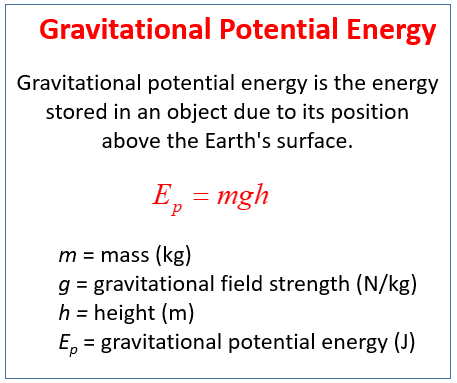Gravitational Potential Energy
A series of free GCSE/IGCSE Physics Notes and Lessons.
In these lessons, we will
- Describe what is meant by gravitational potential energy.
- Calculate the amount of gravitational potential energy gained by an object raised above ground level.
Related Pages
Energy Transfers
Mechanical, Potential and Kinetic Energy
Elastic Potential Energy
Lessons for IGCSE Physics
Gravitational Potential Energy
The following diagram gives the formula for gravitational potential energy. Scroll down the page for more examples and solutions on how to use the formula.

Gravitational potential energy is the energy stored in an object due to its position above the Earth’s surface.
This is due to the force of gravity acting on an object. Gravitational potential energy is
calculated as follows:
Ep = m × g × h
Examples:
- A crane lifts a 75kg mass a height of 8 m. Calculate the gravitational potential energy
gained by the mass (g = 9.8 N/kg).
- A ball with a mass of 500g is lifted onto a shelf which is 1.5m above the ground. Calculate the gravitational potential energy gained by the ball (g = 9.8 N/kg).
Gravitational Potential Energy - IGCSE Physics
Examples:
- How much G.P.E. does a 5kg rock that is 10m above the ground has?.
- A helicopter is flying at a height of 1.5km. If it has 50MJ of G.P.E., what is the mass
of the helicopter?
- A boy throws a 0.2kg rock up with a speed of 5m/s. If all the kinetic energy becomes gravitational potential energy, how high will the stone go?
Try the free Mathway calculator and
problem solver below to practice various math topics. Try the given examples, or type in your own
problem and check your answer with the step-by-step explanations.

We welcome your feedback, comments and questions about this site or page. Please submit your feedback or enquiries via our Feedback page.